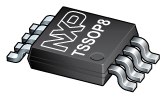

The LM75A is a temperature-to-digital converter using an on-chip band gap temperature sensor and Sigma-delta A-to-D conversion technique. The device is also a thermal detector providing an overtemperature detection output. The LM75A contains a number of data registers: Configuration register (Conf) to store the device settings such as device operation mode, OS operation mode, OS polarity and OS fault queue as described in Section 7 “Functional description”; temperature register (Temp) to store the digital temp reading, and set-point registers (Tos and Thyst) to store programmable overtemperature shutdown and hysteresis limits, that can be communicated by a controller via the 2-wire serial I²C-bus interface. The device also includes an open-drain output (OS) which becomes active when the temperature exceeds the programmed limits. There are three selectable logic address pins so that eight devices can be connected on the same bus without address conflict.
The LM75A can be configured for different operation conditions. It can be set in normal mode to periodically monitor the ambient temperature, or in shutdown mode to minimize power consumption. The OS output operates in either of two selectable modes: OS comparator mode or OS interrupt mode. Its active state can be selected as either HIGH or LOW. The fault queue that defines the number of consecutive faults in order to activate the OS output is programmable as well as the set-point limits.
The temperature register always stores an 11-bit 2's complement data giving a temperature resolution of 0.125 Cel. This high temperature resolution is particularly useful in applications of measuring precisely the thermal drift or runaway.
The device is powered-up in normal operation mode with the OS in comparator mode, temperature threshold of 80 Cel and hysteresis of 75 Cel, so that it can be used as a stand-alone thermostat with those pre-defined temperature set points
Advertisement
Learn more about NXP Semiconductors





